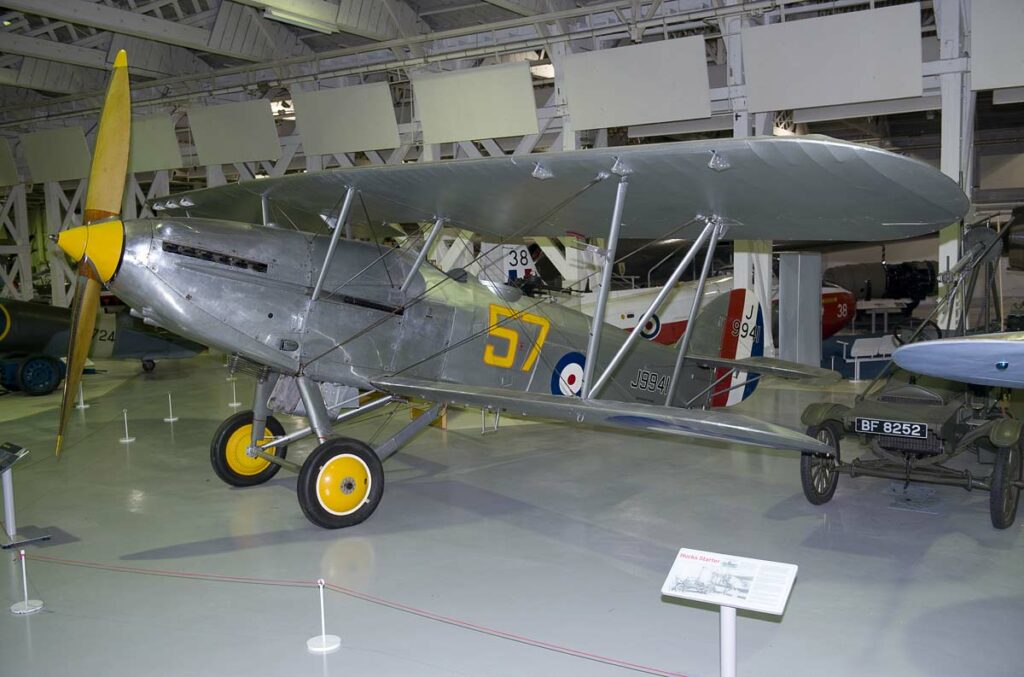The Hawker Hart, an iconic 1930s British biplane, was a light bomber renowned for its Rolls-Royce Kestrel engine, high speed, and maneuverability. This article provides a comprehensive overview of the Hawker Hart, detailing its development, design, performance, and military usage. It highlights the aircraft’s significance in the interwar period, its innovative features, and its role in various military operations.
The Hawker Hart holds a prominent place in the history of military aviation as a leading British light bomber of the interwar period. It represented a significant leap in aviation technology and tactics. This article explores the development, design, performance, and operational use of the Hawker Hart.
History of the Development of the Hawker Hart:
During the late 1920s, the rapidly evolving field of aviation witnessed a need for faster, more efficient military aircraft. The Hawker Hart was developed in this context, as air forces worldwide sought to upgrade their capabilities with modern, reliable aircraft.
The development of the Hart was initiated by Hawker Aircraft Ltd, led by the legendary aircraft designer Sydney Camm. The project began with the aim of creating a light bomber that could outperform the existing models in speed, range, and payload capacity. The first prototype of the Hawker Hart flew in 1928, demonstrating a remarkable performance that exceeded expectations.
This era was marked by significant advancements in aerodynamics and engine technology. The Hart was designed in response to the Air Ministry’s specification, seeking a new light day bomber capable of meeting the challenges of modern aerial warfare.
Design of the Hawker Hart:
The Hawker Hart was a masterpiece of design for its time. It was a two-seat biplane with a wingspan of 37 feet 3 inches (11.35 meters) and a length of 29 feet 4 inches (8.94 meters). The aircraft featured a mixed construction, with a metal frame and fabric covering.
Powered by the Rolls-Royce Kestrel IB V-12 liquid-cooled engine, the Hart was capable of delivering 525 horsepower (391 kW). This engine was a crucial component of the Hart’s design, providing exceptional power and reliability.
The Hart’s design incorporated several advanced features for its time, such as an all-metal fuselage, a streamlined shape for better aerodynamic efficiency, and a capability to carry a significant payload. However, its biplane configuration and open cockpit design were seen as limitations compared to the emerging monoplane designs.
Despite these drawbacks, the Hart set new standards in light bomber design, particularly in terms of speed and agility.

Performance of the Hawker Hart:
In terms of performance, the Hawker Hart was outstanding for its era. The Rolls-Royce Kestrel engine enabled a top speed of around 184 mph (296 km/h), a service ceiling of about 22,800 feet (6,950 meters), and a range of approximately 470 miles (756 km).
When compared to its contemporaries, such as the American Douglas B-18 Bolo or the German Heinkel He 111, the Hart was superior in terms of speed and maneuverability. Its performance was particularly remarkable, given that it was faster than most contemporary fighters.
Military Use and Combat of the Hawker Hart:
The Hawker Hart was primarily used by the Royal Air Force and saw extensive service in various roles, including light bombing, reconnaissance, and training. Its armament typically consisted of one forward-firing Vickers machine gun and one Lewis gun mounted in the rear cockpit, along with the capacity to carry up to 520 pounds (236 kg) of bombs.
The Hart saw action in several conflicts, notably in the British Empire’s colonial campaigns in the 1930s. Its speed and reliability made it a valuable asset in these operations. The aircraft was also exported to a number of countries, extending its service worldwide.
The Hart was eventually replaced by more advanced monoplane designs, such as the Hawker Hurricane, as technology progressed.
The Hawker Hart stands as a landmark in aviation history, embodying the technological advancements and tactical evolution of the interwar period. Its innovative design, remarkable performance, and versatility in various military roles made it one of the most significant aircraft of its time. The Hart not only served with distinction but also influenced the development of subsequent aircraft, leaving a lasting legacy in the annals of military aviation.
Back to the Bombers section.